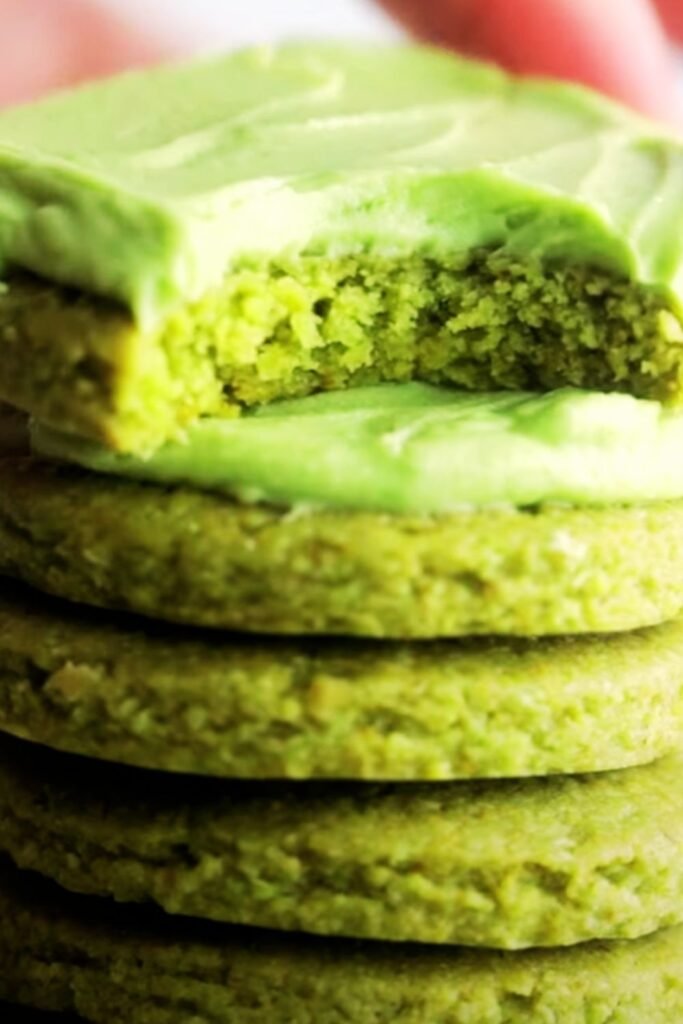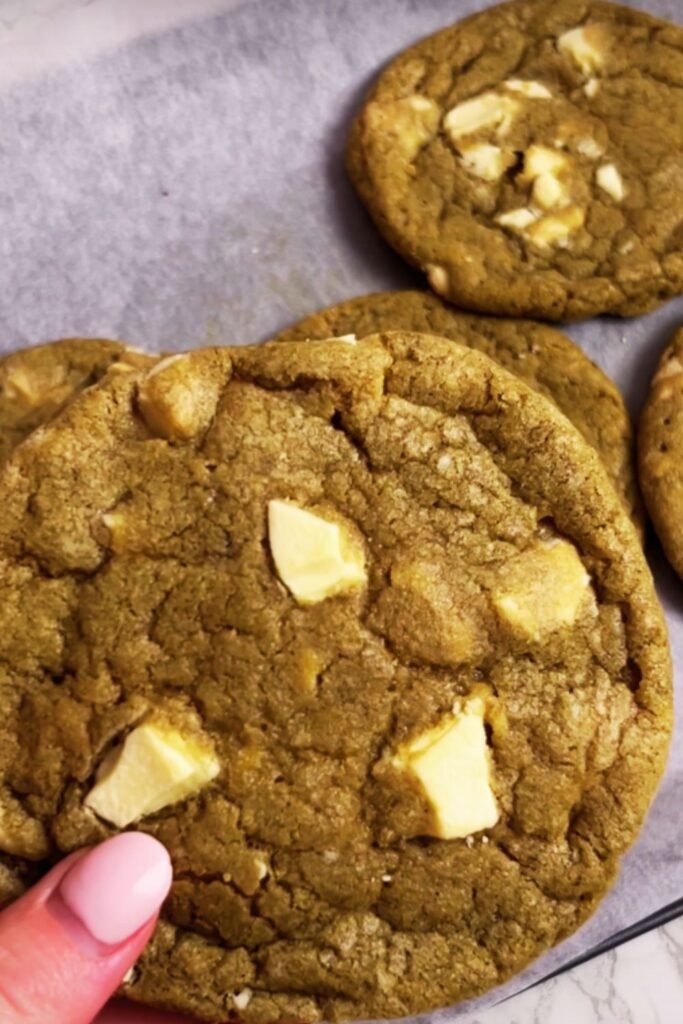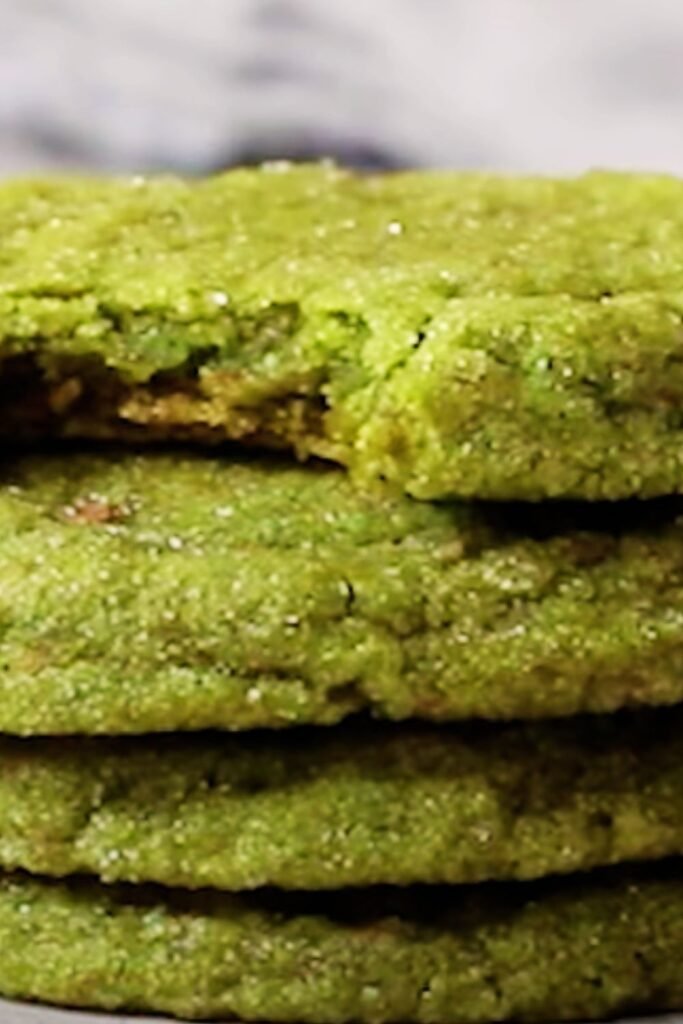When I first discovered the magical combination of earthy matcha and sweet cookie dough, I knew I had found something special. These vegan matcha cookies have become my absolute favorite treat to bake, and I’m excited to share everything I’ve learned about perfecting them with you.
There’s something incredibly satisfying about creating cookies that are not only delicious but also align with plant-based values. The vibrant green color of matcha powder transforms ordinary cookies into something extraordinary, while the unique umami-sweet flavor profile creates an experience that’s both familiar and exotic.
Understanding Matcha in Baking
Matcha is a finely ground powder made from specially grown and processed green tea leaves. Unlike regular green tea, matcha involves consuming the entire leaf, which provides a more intense flavor and higher concentration of nutrients.
Ceremonial Grade Matcha represents the highest quality, made from the youngest tea leaves with stems and veins removed. This grade offers the smoothest, most refined flavor perfect for baking.
Culinary Grade Matcha is specifically designed for cooking and baking applications. It has a stronger, more robust flavor that can stand up to other ingredients without being overpowered.
Organic Matcha ensures the tea leaves were grown without synthetic pesticides or fertilizers, making it an excellent choice for health-conscious bakers.
When I started experimenting with matcha in my baking, I quickly learned that quality matters tremendously. The difference between using premium matcha and lower-grade powder is immediately apparent in both flavor and color intensity.
Essential Ingredients for Perfect Vegan Matcha Cookies
Creating exceptional vegan matcha cookies requires understanding how plant-based ingredients work together. Each component plays a crucial role in achieving the perfect texture, flavor, and appearance.
Base Ingredients Analysis
| Ingredient | Function | Vegan Alternative | Quantity per Batch |
|---|---|---|---|
| All-purpose flour | Structure and texture | Same | 2 cups |
| Matcha powder | Flavor and color | Same | 2-3 tablespoons |
| Coconut oil | Fat for richness | Replaces butter | 1/2 cup |
| Maple syrup | Natural sweetener | Replaces eggs partially | 1/4 cup |
| Vanilla extract | Flavor enhancement | Same | 1 teaspoon |
| Baking powder | Leavening agent | Same | 1 teaspoon |
| Salt | Flavor balance | Same | 1/4 teaspoon |
| Plant milk | Moisture | Replaces dairy milk | 2-3 tablespoons |
Sweetening Options Comparison
| Sweetener Type | Flavor Profile | Texture Impact | Recommended Amount |
|---|---|---|---|
| Coconut sugar | Caramel undertones | Slightly granular | 3/4 cup |
| Maple syrup | Rich, complex | Adds moisture | 1/2 cup |
| Agave nectar | Neutral, clean | Very smooth | 1/3 cup |
| Date syrup | Deep, fruity | Dense texture | 1/2 cup |
| Stevia blend | Clean, sweet | Minimal impact | 1/4 cup |
The choice of sweetener significantly influences the final cookie texture. I’ve found that combining coconut sugar with a small amount of maple syrup creates the perfect balance of sweetness and texture.
My Perfected Vegan Matcha Cookie Recipe
After countless batches and recipe adjustments, I’ve developed what I consider the ultimate vegan matcha cookie recipe. These cookies strike the perfect balance between chewy and crispy, with an intense matcha flavor that isn’t overpowering.
Ingredients:
- 2 cups all-purpose flour
- 3 tablespoons high-quality culinary grade matcha powder
- 3/4 cup coconut sugar
- 1/4 cup maple syrup
- 1/2 cup melted coconut oil (cooled slightly)
- 3 tablespoons unsweetened almond milk
- 1 teaspoon vanilla extract
- 1 teaspoon baking powder
- 1/4 teaspoon salt
- 2 tablespoons cornstarch (for extra chewiness)
Step-by-Step Instructions:
Preparation Phase:
- Preheat your oven to 350°F (175°C) and line two baking sheets with parchment paper
- Sift the matcha powder through a fine-mesh strainer to eliminate any lumps
- Allow the melted coconut oil to cool to room temperature
Mixing Process:
- In a large mixing bowl, whisk together the flour, sifted matcha powder, baking powder, salt, and cornstarch
- Create a well in the center of the dry ingredients
- In a separate bowl, combine the coconut sugar, maple syrup, cooled coconut oil, almond milk, and vanilla extract
- Pour the wet ingredients into the well of dry ingredients
- Using a wooden spoon or spatula, gently fold the ingredients together until just combined
Shaping and Baking:
- Using a cookie scoop or spoon, portion the dough into 1.5-inch balls
- Place them on the prepared baking sheets, spacing them 2 inches apart
- Gently flatten each ball with your fingers or the back of a fork
- Bake for 10-12 minutes, until the edges are set but centers still look slightly soft
- Allow cookies to cool on the baking sheet for 5 minutes before transferring to a wire rack

Troubleshooting Common Issues
Through my baking journey, I’ve encountered and solved numerous challenges with vegan matcha cookies. Here are the most common problems and my proven solutions:
Texture Problems and Solutions
| Issue | Cause | Solution |
|---|---|---|
| Cookies too dry | Insufficient fat or liquid | Add 1-2 tbsp more plant milk |
| Cookies too soft | Too much liquid or underbaked | Reduce liquid by 1 tbsp, bake 2 min longer |
| Cookies spread too much | Warm dough or too much fat | Chill dough 30 min before baking |
| Cookies don’t spread | Dough too cold or dry | Bring to room temp, add 1 tbsp liquid |
| Crumbly texture | Overmixing or wrong flour ratio | Mix just until combined |
Flavor Enhancement Techniques
The key to exceptional matcha cookies lies in balancing the natural bitterness of matcha with complementary flavors. I’ve discovered several techniques that elevate the overall taste profile:
Matcha Quality Assessment:
- Color should be vibrant jade green, not yellowish or dull
- Texture should be incredibly fine, almost like face powder
- Aroma should be fresh and grassy, not stale or musty
- Taste should be vegetal with subtle sweetness, not overly bitter
Flavor Pairing Strategies:
- White chocolate chips (vegan) complement matcha’s earthiness
- Chopped pistachios add texture and nutty richness
- Coconut flakes enhance the tropical undertones
- Lemon zest brightens the overall flavor profile
Advanced Variations and Customizations
Once you’ve mastered the basic recipe, the world of matcha cookie variations opens up endless possibilities. I love experimenting with different add-ins and techniques to create unique flavors and textures.
Texture Variations
Chewy Matcha Cookies:
- Add an extra 2 tablespoons of maple syrup
- Reduce baking time by 2 minutes
- Use brown coconut sugar instead of regular
Crispy Matcha Cookies:
- Reduce liquid ingredients by 1 tablespoon
- Roll dough thinner before baking
- Bake for an additional 2-3 minutes until edges are golden
Soft-Batch Style:
- Add 1 tablespoon of cornstarch to the flour mixture
- Include 2 tablespoons of applesauce
- Store with a slice of bread to maintain moisture

Flavor Combinations
| Combination | Additional Ingredients | Flavor Profile |
|---|---|---|
| Matcha White Chocolate | 1/2 cup vegan white chocolate chips | Sweet and creamy |
| Matcha Pistachio | 1/3 cup chopped pistachios | Nutty and sophisticated |
| Matcha Coconut | 1/4 cup shredded coconut | Tropical and rich |
| Matcha Ginger | 1 tsp ground ginger | Warm and spicy |
| Matcha Lemon | Zest of 1 lemon | Bright and citrusy |
Storage and Freshness Tips
Proper storage is crucial for maintaining the quality and flavor of your vegan matcha cookies. I’ve learned through experience that these cookies have specific storage requirements due to their unique ingredients.
Short-Term Storage (1-3 days):
- Store in an airtight container at room temperature
- Layer cookies between parchment paper to prevent sticking
- Keep away from direct sunlight to preserve the matcha color
Long-Term Storage (up to 2 weeks):
- Freeze in freezer-safe containers with tight-fitting lids
- Wrap individual cookies in plastic wrap before freezing
- Thaw at room temperature for 15-20 minutes before serving
Matcha Powder Storage:
- Keep in an airtight container in the refrigerator
- Use within 12 months for best flavor
- Avoid exposure to light and moisture
Nutritional Benefits of Vegan Matcha Cookies
Beyond their delicious taste, these cookies offer several nutritional advantages over traditional recipes. The combination of matcha and plant-based ingredients creates a treat that’s both indulgent and relatively wholesome.
Matcha Nutritional Profile
| Nutrient | Amount per serving | Benefit |
|---|---|---|
| Antioxidants (EGCG) | 130mg | Anti-inflammatory properties |
| Caffeine | 35mg | Natural energy boost |
| L-theanine | 15mg | Promotes calm focus |
| Vitamin C | 3mg | Immune system support |
| Chlorophyll | 5mg | Detoxification support |
Plant-Based Ingredient Benefits:
- Coconut oil provides healthy medium-chain fatty acids
- Almond milk offers vitamin E and calcium
- Maple syrup contains antioxidants and minerals
- Coconut sugar has a lower glycemic index than regular sugar
Serving Suggestions and Pairings
The versatility of vegan matcha cookies makes them perfect for various occasions and pairings. I’ve discovered numerous ways to serve and enjoy these treats throughout different times of day.
Beverage Pairings:
- Morning: Pair with matcha latte or green tea
- Afternoon: Enjoy with herbal tea or plant-based milk
- Evening: Serve with chamomile tea or warm almond milk
Occasion-Based Serving:
- Tea parties: Arrange on tiered serving trays with fresh berries
- Picnics: Pack in individual containers for easy transport
- Gifts: Present in decorative tins with ribbon
- Dessert courses: Serve alongside coconut ice cream

Seasonal Adaptations
Throughout the year, I love adapting my basic matcha cookie recipe to reflect seasonal flavors and ingredients. These variations keep the recipe fresh and exciting while maintaining the core matcha character.
Spring Variations:
- Add dried cherry pieces for a sakura-inspired flavor
- Incorporate lemon zest for brightness
- Use strawberry powder for a subtle fruit note
Summer Adaptations:
- Mix in freeze-dried raspberries
- Add coconut flakes for tropical appeal
- Include mint extract for cooling freshness
Fall Modifications:
- Blend in pumpkin pie spice
- Add chopped candied ginger
- Include orange zest for warmth
Winter Enhancements:
- Incorporate vanilla bean paste
- Add warming spices like cardamom
- Include dark chocolate chips for richness
Professional Tips for Perfect Results
After years of perfecting my technique, I’ve developed several professional tips that consistently produce exceptional vegan matcha cookies. These insights come from both successes and failures in my kitchen.
Measuring Techniques:
- Always sift matcha powder to prevent lumps
- Use a kitchen scale for precise measurements
- Level flour measurements with a knife edge
- Don’t pack coconut sugar when measuring
Temperature Control:
- Ensure coconut oil is cooled but still liquid
- Chill dough if it becomes too soft to handle
- Rotate baking sheets halfway through baking time
- Use an oven thermometer to verify accurate temperature
Timing Considerations:
- Don’t overbake – cookies continue cooking on hot pans
- Allow proper cooling time for texture development
- Mix ingredients just until combined to avoid toughness
- Time each batch consistently for uniform results
Quality Ingredient Sourcing
The success of these cookies heavily depends on ingredient quality, particularly the matcha powder. I’ve researched and tested numerous suppliers to identify the best sources for home bakers.
Matcha Selection Criteria:
- Origin: Japanese matcha typically offers superior quality
- Processing: Stone-ground varieties provide better texture
- Packaging: Sealed tins protect from light and air
- Color: Vibrant green indicates freshness and quality
Reliable Ingredient Sources:
- Specialty tea shops: Often carry high-quality matcha
- Asian markets: Good selection and competitive prices
- Online retailers: Convenient with detailed product information
- Health food stores: Organic options available
Troubleshooting Advanced Issues
As you become more experienced with this recipe, you might encounter more subtle issues that require advanced troubleshooting skills. Here are solutions to complex problems I’ve encountered:
Color and Appearance Issues:
| Problem | Cause | Solution |
|---|---|---|
| Dull green color | Low-quality matcha | Invest in better matcha powder |
| Uneven color | Inadequate sifting | Sift matcha multiple times |
| Brown spots | Overheating | Reduce oven temperature by 25°F |
| Pale cookies | Insufficient matcha | Increase matcha by 1 tablespoon |
Advanced Texture Problems:
- Gritty texture: Usually indicates inadequate sifting of matcha
- Oily appearance: Coconut oil was too warm when mixed
- Dense cookies: Overmixing developed too much gluten
- Uneven baking: Oven hot spots or incorrect rack position
Q&A Section
Q: Can I substitute the matcha powder with green tea powder? A: While you can substitute green tea powder, the flavor will be much milder and less complex than true matcha. Matcha undergoes a special growing and processing method that creates its unique taste profile and nutritional benefits.
Q: Why do my cookies spread too much during baking? A: Excessive spreading usually occurs when the dough is too warm or contains too much fat. Try chilling your dough for 30 minutes before baking, and ensure your coconut oil has cooled to room temperature before mixing.
Q: How can I make my cookies more chewy? A: For chewier cookies, add an extra tablespoon of maple syrup and reduce the baking time by 2-3 minutes. The cookies should look slightly underdone when you remove them from the oven.
Q: Can I use different types of flour? A: Yes, but the texture will change. Almond flour creates a more delicate, crumbly texture, while whole wheat flour makes them denser. I recommend substituting no more than half the all-purpose flour with alternative flours.
Q: How do I know if my matcha powder is fresh? A: Fresh matcha should be vibrant green in color, have a grassy aroma, and taste vegetal with subtle sweetness. If it’s yellowish, odorless, or bitter, it’s likely old and should be replaced.
Q: Can I make these cookies gluten-free? A: Absolutely! Replace the all-purpose flour with a 1:1 gluten-free flour blend. Add an extra tablespoon of cornstarch to help with binding, and be prepared for a slightly different texture.
Q: Why do my cookies taste bitter? A: Bitterness usually comes from using too much matcha powder or low-quality matcha. Start with 2 tablespoons of matcha and adjust to taste. Also, ensure you’re using culinary grade matcha designed for baking.
Q: How long do these cookies stay fresh? A: When stored properly in an airtight container, these cookies maintain their best quality for up to one week at room temperature. For longer storage, freeze them for up to three months.
Q: Can I double the recipe? A: Yes, this recipe doubles well. Just make sure to mix in batches to avoid overworking the dough, and you may need to bake in multiple batches depending on your oven capacity.
Q: What’s the best way to achieve uniform cookie sizes? A: Use a cookie scoop or measuring spoon to portion the dough consistently. A 1.5-tablespoon scoop creates perfectly sized cookies that bake evenly.
These vegan matcha cookies represent the perfect intersection of health-conscious baking and indulgent flavor. The earthy complexity of matcha combined with the wholesome satisfaction of plant-based ingredients creates a treat that satisfies both your taste buds and your values. Whether you’re serving them at a tea party, packing them for a picnic, or simply enjoying them with your afternoon beverage, these cookies deliver consistent delight with every bite.
The key to success lies in understanding your ingredients, particularly the matcha powder that gives these cookies their distinctive character. Quality matcha transforms an ordinary cookie into something extraordinary, while proper technique ensures consistent results every time. As you become more comfortable with this recipe, don’t hesitate to experiment with the variations and adaptations I’ve shared – that’s where the real magic happens in baking.
Remember that baking is both an art and a science. While following the recipe precisely will give you excellent results, understanding the why behind each step empowers you to troubleshoot issues and create your own unique variations. These cookies have become a staple in my kitchen, and I’m confident they’ll become a favorite in yours too.